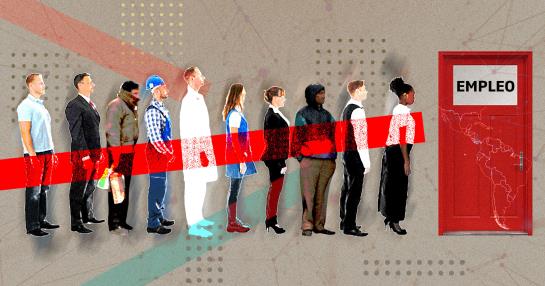In the middle of the street or on social networks, a request becomes recurring: I’m looking for a job. Maura Mayta is a single mother and every day she settles on a busy street corner in Cochabamba to offer her cleaning services. “I work casually, per day I have to make my profit and sometimes there isn’t. I would like to have a monthly income, a permanent job, even if it is part time”, she says while she waits for someone to hire her at least for that day.
But that doesn’t just happen to people without higher education. On Twitter, for example, every day professionals from various areas take advantage of its 280 characters to try to sell their skills, looking for opportunities in a virtual world of strangers.
Although the forecasts in Latin America point to the unemployment would drop to 9.3% this year compared to 10% in 2021, the outlook is still grim and uncertain for thousands of people that carry on their backs the deterioration of the economy and the slow progress of the reactivation of the labor market. The International Labor Organization (ILO) states that it could take until 2023 or 2024 to recover pre-pandemic levels.
The professor of Economic Development at the National University of Cuyo, Argentina, Raúl Mercau, explains the labor implications of this new stage in which many countries are lifting the measures imposed by the pandemic: “For some workers who belong to vulnerable sectors, who are of a certain age and do not recover, their productive reconversion is very difficult, they will surely have a permanent injury and will be expelled from the labor market without being able to reintegrate into the system. That group would be the chronically unemployed,” he told CONNECT.
According to the report Social perspectives and unemployment in the world 2022 According to the ILO, this year there will be 28.8 million unemployed in the subcontinent and 27.6 million in 2023. In 2019, the number stood at 24.3 million.
Informality is not a way out
Quality work has been greatly reduced by the massive layoffs and closures of factories and companies during the worst crisis of the pandemic. that leaves informality as an option for many.
In this regard, the ILO says that the informal labor force represents more than half of the total number of people employed in Latin America, and Bolivia has the highest rate of informality in the region and one of the highest worldwide.
Ecuador, Peru and Colombia have more than 60% of their population employed in informal salaried jobs. In the case of Mexico and Brazil, the largest Latin American economies, the percentage rises to 57% and 47%, respectively.
The picture is different in Chile and Uruguay, where there is more formal than informal employment, and both with an informality rate below 30%.
“The formal in Bolivia is informality and that means that between 75 to 80% of the economy is informal. It is an extremely high figure according to international standards”, says Iván Velásquez, project coordinator of the Konrad Adenauer Foundation in Bolivia and author of the study “Informal economy and informality in a multiethnic society”, where he also delves into the incidence of a “poverty scenario at the urban and rural levels, high rates of unemploymentunderemployment, gender inequality and precarious, insecure and poorly paid work”.
Velásquez emphasizes that “informality is the escape to be able to generate income more quickly because the economic units in this sector are not looking for large sums of money, but the subsistence of the moment.”
Populist speech “to the rescue”
Recovery depends on the measures taken by governments, but in any case there will be marked differences and more inequality that will lead to long-term consequences.
In Colombia, for example, in the midst of an intense electoral campaign towards the presidential elections, the polls point to employment as the main concern of citizens. And in this area the candidate of the Historical Pact, Gustavo Petro, who leads the polls, raises the ‘Guaranteed Employment Policy’.
In this proposal, it places the State at the center so that it acts as the employer of last resort, offering employment with a basic salary to those who can and want to work, but cannot find a way to do so in the private sector. The approach seems to reflect a populist tendency that could have serious consequences due to its high costs and its possible effect on productivity.
On the other hand, in Argentina, President Alberto Fernández, who announced his candidacy for re-election this week, is eloquent with a speech that sells the reactivation of the economy and goes further: “We have recovered work, but we have to recover the salary , which fell between 2015 and 2019, and that requires asking the powerful to properly distribute wealth.” An idea so general that it does not settle in the complex reality of that country.
“While it is true that jobs have been recovering in Argentina and the rate of unemployment it is relatively low, we are close to 7% in the last quarter of last year, the problem is that while prices go up, salaries go down the stairs. So, in this race of prices and wages, the one who has the most losses is truly the worker”, he explained to CONNECT Professor Mercau.
Migrants: the other reality
But this is only a small part of the immense problem of unemployment. A situation that affects the issue of migrants.
Recently, the United States and Mexico, during a meeting prior to the ninth Summit of the Americas, proposed to address the structural problems of migration through a joint investment and job creation plan for Central America.
The Secretary of State, Antony Blinken, said that Mexico’s collaboration is vital to face what he considers an “unprecedented migratory challenge in the entire hemisphere.” According to him “World Migration Report 2022”, The United States has been the first destination for international migrants since 1970.
But, for the Mexican economist Jimy Cruz, “migrants have to go where there are job opportunities and the migratory wave will not be contained as long as there is the stimulus of the great labor demand of an economy like the United States, which has reactivated a lot faster than in the rest of the countries of Latin America”.
The expert also refers to the so-called “Great Resignation”, a phenomenon by which a significant number of American workers have left their jobs since the beginning of the pandemic, reaching a record 4.5 million in November 2021, reported this week. the Bureau of Labor Statistics.
This scenario is then presented as an opportunity for immigrants who could solve the labor shortage in the United States, specifically in the health, computing and mathematics, cleaning and building maintenance sectors. An study released by the American Immigration Council calculates that “by 2030 there will be about 165 million jobs in that country, and almost half, about 80 million, will be vacant due to retirements, career changes or people who simply leave the labor market.”
But of course the solution to unemployment in Latin America cannot go through mass migration to the United States, nor is this society willing to receive it. The lack of work is a reality that we come across every day and that translates into a more vulnerable economy, a slower development, and in countries that do not offer the conditions to live with dignity and better opportunities. Real solutions are urgently needed.
Every week, the Latin American journalism platform CONNECTAS publishes analyzes of current events in the Americas. If you are interested in reading more information like this, you can go to this link.








